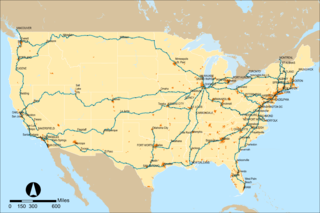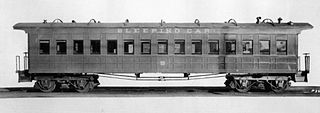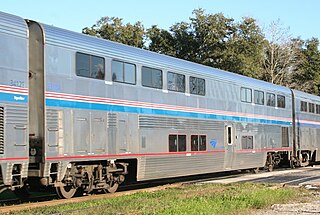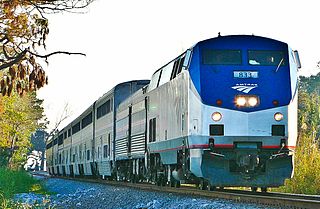
In rail transport, a train is a series of connected vehicles that run along a railway track and transport people or freight. The word train comes from the Old French trahiner, derived from the Latin trahere meaning "to pull, to draw". Trains are typically pulled or pushed by locomotives, though some are self-propelled, such as multiple units. Passengers and cargo are carried in railroad cars, also known as wagons. Trains are designed to a certain gauge, or distance between rails. Most trains operate on steel tracks with steel wheels, which allows low friction and makes them more efficient than other forms of transport.

The National Railroad Passenger Corporation, doing business as Amtrak, is a passenger railroad service that provides medium and long-distance inter-city rail service in the contiguous United States and to nine cities in Canada.

Inter-city rail services are express passenger train services that cover longer distances than commuter or regional trains.

The sleeping car or sleeper is a railway passenger car that can accommodate all passengers in beds of one kind or another, primarily for the purpose of making nighttime travel more comfortable. George Pullman was the American innovator of the sleeper car.

A railcar is a self-propelled railway vehicle designed to transport passengers. The term "railcar" is usually used in reference to a train consisting of a single coach, with a driver's cab at one or both ends. Some railway companies, such as the Great Western, termed such vehicles "railmotors".

The Southern Pacific was an American Class I railroad network that existed from 1865 to 1996 and operated largely in the Western United States. The system was operated by various companies under the names Southern Pacific Railroad, Southern Pacific Company and Southern Pacific Transportation Company.

The Chicago, Rock Island and Pacific Railroad was an American Class I railroad. It was also known as the Rock Island Line, or, in its final years, The Rock.

In railroad terminology, a stock car, cattle car, cattle truck or cattle wagon is a type of rolling stock used for carrying livestock to market. A traditional stock car resembles a boxcar with louvered instead of solid car sides for the purpose of providing ventilation; stock cars can be single-level for large animals such as cattle or horses, or they can have two or three levels for smaller animals such as sheep, pigs, and poultry. Specialized types of stock cars have been built to haul live fish and shellfish and circus animals such as camels and elephants. Until the 1880s, when the Mather Stock Car Company and others introduced "more humane" stock cars, death rates could be quite high as the animals were hauled over long distances. Improved technology and faster shipping times have greatly reduced deaths.

A passenger railroad car or passenger car, also called a passenger carriage, passenger coach, or passenger bogie (India) is a railroad car that is designed to carry passengers. The term passenger car can also be associated with a sleeping car, a baggage car, a dining car, railway post office and prisoner transport cars.

The Sunset Limited is an Amtrak passenger train that for most of its history has run between New Orleans and Los Angeles, over the nation's second transcontinental route. However, up until Hurricane Katrina in 2005, it ran between Orlando and Los Angeles, and from 1993 to 1996, continued on to Miami. It is the oldest continuously operating named train in the United States, introduced in 1894 by the Southern Pacific Railroad, and acquired by Amtrak upon its formation in 1971.
In 1948, 14 railroads in North America owned more than 1,000 steam locomotives each. See also: Historical sizes of railroads

Rail transportation in the United States consists primarily of freight shipments, with a well integrated network of standard gauge private freight railroads extending into Canada and Mexico. Passenger service is mainly mass transit and commuter rail in major cities. Intercity passenger service, once a large and vital part of the nation's passenger transportation network, plays a limited role as compared to transportation patterns in many other countries. The United States has the largest rail transport network size of any country in the world.

Rail freight transport is the use of railroads and trains to transport cargo as opposed to human passengers.

The Slumbercoach is an 85-foot-long, 24 single room, eight double room streamlined sleeping car. Built in 1956 by the Budd Company for the Chicago, Burlington and Quincy Railroad for service on the Denver Zephyr, subsequent orders were placed in 1958 and 1959 by the Baltimore and Ohio Railroad and Missouri Pacific Railroad for the Texas Eagle/National Limited, then in 1959 by the Northern Pacific Railway for its North Coast Limited and also the New York Central Railroad for use on the 20th Century Limited.

Rail transport in Russia runs on one of the biggest railway networks in the world. Russian railways are the third longest by length and third by volume of freight hauled, after the railways of the United States and China. In overall density of operations /length of track, Russia is second only to China. Rail transport in Russia has been described as one of the economic wonders of the 19th, 20th, and 21st centuries.

A private railroad car, private railway coach, private car or private varnish is a railroad passenger car which was either originally built or later converted for service as a business car for private individuals. A private car could be added to the make-up of a train or pulled by a private locomotive, providing privacy for its passengers. They were used by railroad officials and dignitaries as business cars, and wealthy individuals for travel and entertainment, especially in the United States. They were sometimes used by politicians in "whistle stop campaigns". Pay cars with less opulent sleeping and dining facilities were used by a paymaster and assistants to transport and disburse cash wages to railway employees in remote locations without banking facilities.

The National Limited was the premier train of the Baltimore and Ohio Railroad (B&O) on its route between New York City and St. Louis, Missouri, with major station stops in Washington, D.C., and Cincinnati, Ohio. It operated from 1925 to 1971. For much of its life it offered exclusive all-Pullman service, and it was the first long-distance train to be entirely air-conditioned. The National Limited was one of many trains discontinued when Amtrak began operations on May 1, 1971. Amtrak revived the name for another New York–St. Louis service which did not use the B&O route.

The Texas Department of Transportation (TxDOT) is a governmental agency and its purpose is to "provide safe, effective, and efficient movement of people and goods" throughout the state. Though the public face of the agency is generally associated with maintenance of the state's immense highway system, the agency is also responsible for aviation in the state and overseeing public transportation systems.

Cuyahoga Valley Scenic Railroad is a Class III railroad operating diesel-electric and steam-powered excursion trips through Peninsula, Ohio in the Cuyahoga Valley, primarily through the scenic Cuyahoga Valley National Park.

On the night of Wednesday, June 21, 1905, the New York Central Railroad's flagship passenger train, the 20th Century Limited, derailed in Mentor, Ohio, on the Lake Shore and Michigan Southern Railway line, killing 21 passengers and injuring more than 25 others on board. A switch from the mainline to a freight siding was open, causing the Limited to leave the mainline and overrun the siding at high speed. The cause of the accident was never officially determined, but overwhelming evidence points to deliberate sabotage of the switch. The 20th Century Limited connected New York City to Chicago; its running time had just weeks earlier been reduced from 20 hours to 18.























